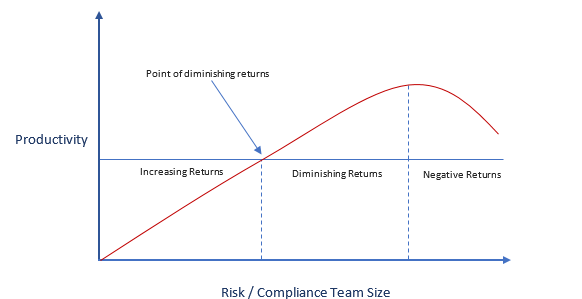Home/ Blog / Overcoming the Diminishing Returns in Risk and Compliance Management
The law of diminishing returns, which states that after a certain point adding resources only gives marginal value, is certainly true for risk and compliance management. Organizations that try to improve compliance levels and risk mitigation by increasing risk and compliance personnel end up realizing that the improvement does not justify the increased payroll expenses.
The Law of Diminishing Returns for Risk and Compliance Productivity
What is the law of diminishing returns?
The law of diminishing returns states that if all other factors remain constant, increasing only one factor will only increase productivity to a certain level, after which the marginal utility of each unit added will decrease, and eventually the overall productivity will start dropping. In the compliance and risk context, the diminishing law of returns means that adding team members to risk and compliance departments, without changing other factors, will increase productivity proportionally up to a point, after which each member added will deliver a lower bump in productivity.
The cost of increasing risk and compliance team sizes
While the law of diminishing returns can be observed in almost all business processes and domains, it is a particularly significant factor for risk and compliance teams due to the specialized nature of work. Risk and compliance personnel are highly skilled, specially trained and certified individuals in a niche domain. The wages of specialized labor in a demanding and significant domain like risk and compliance tend to be higher than average wages. Thus, not only are banks and other financial institutions getting lower productivity, they are also usually paying a much higher price for adding more human resources to these domains.
The overlooked ‘other factors’
‘’keeping other factors constant’’ is an important part of the law of diminishing returns that is often overlooked. The law of diminishing returns is not meant to be a defeatist approach that proclaims that there is no way to increase productivity and organizations will get lower returns if they increase investment. Instead, it is meant to show that only focusing on one factor and increasing it will result in diminishing returns, which means that the smarter approach is to focus on other factors as well. For risk and compliance teams, this means that while simply increasing personnel will provide diminishing returns, organizations should focus elsewhere if they want to achieve higher productivity.
GRC solutions provide an interface and a forum that allows employees across the organization to collaborate on making risk mitigation and compliance management improvement. Share on XThe impact of technology in increasing risk and compliance productivity
If we look at how other industries and domains have dealt with this problem the answer becomes clear – technology is the factor that needs to be changed. We can observe how technology has helped other domains achieve higher productivity levels than ever before without significantly increasing personnel. The banking industry is a great example. The productivity of banking has exploded exponentially thanks to information technology.
Retail banking was slow and cumbersome before the advent of information technology. Multiple people needed to be involved in every transaction, confirming documents and keeping records to ensure compliance and lower risks. Now, a single bank employee with a computer can accomplish more than a team used to be able to accomplish a few decades ago. With a few clicks they can verify transactions, trade globally, and ensure compliance. Tasks that used to take days to verify because they involved multiple branches in different locations can now be done in a matter of minutes thanks to the banking network.
Another important factor to consider is that other industries haven’t simply increased the efficiency of their existing services through IT – they have started offering new services which were not possible before IT. Internet banking, instantaneous fund transfers, and real-time notifications are just some of the features which are only possible because of IT.
The impact of risk and compliance technology on productivity
Risk and compliance technology bring similar improvements and benefits to risk and compliance management teams. GRC (governance, risk, and compliance) solutions improve productivity by introducing:
- Robotic Process Automation
- Streamlined Workflows
- Activity Monitoring
- Collaboration Frameworks
- Real-time Analysis
Robotic Process Automation
Many risk and compliance processes are completely automated with GRC technology. The automation of monitoring as well as report generation processes frees up the employees and allows them to focus on the big picture. Instead of doing menial tasks manually, the teams can focus on creating new strategies and implementing changes that help the organization achieve its vision.
Streamlined Workflows
Many risk and compliance processes cannot be automated because they need the inputs and insights of experienced and skilled employees. GRC solutions streamline the workflow of such tasks, providing interfaces and features which allow these tasks to be more visible and easier to manage.
Activity Monitoring
GRC solutions allow management to monitor all risk and compliance activities that are on-going, scheduled, or have been completed throughout the organization. Instead of having to wait for a report to be generated, they can get a top-level view of each department, and drill down to get more information about a specific activity.
Collaboration Frameworks
GRC solutions provide an interface and a forum that allows employees across the organization to collaborate on making risk mitigation and compliance management improvement. By including all stakeholders, and not just the risk and compliance departments, these frameworks ensure that every facet of risk and compliance is being managed and considered.
Real-Time Analysis
GRC solutions also centralize risk and compliance data, and then provides real-time analysis of the data. If a risk goes up, it is instantly detected, and a notification is sent out to the risk management department. Similarly, if there is a compliance violation, it is instantly detected, and the relevant stakeholders are notified. Management has a dashboard which shows a real-time analysis of risk, compliance, and other KPIs (key performance indicators).
These 5 factors work together to deliver exponentially higher risk and compliance productivity with the same number of personnel. Instead of increasing the headcount, technology allows us to augment our existing employees and use our human resources with a higher efficiency, offloading the menial and monitoring task to software solutions.
Interested in finding more about how risk and compliance technology can help your organization get higher productivity levels? Get in touch with the 360factors team for a demo of Predict360, our GRC solution.
Request a Demo
Complete the form below and our business team will be in touch to schedule a product demo.
By clicking ‘SUBMIT’ you agree to our Privacy Policy.




